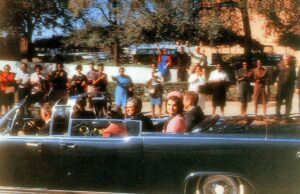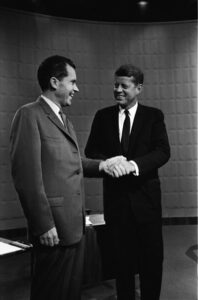In November of 1960, Thomas Randall was 15 years old and living on Long Island, New York when then-U.S. Senator John F. Kennedy was campaigning for President of the United States and visited Long Island that month. Randall remembers going to a campaign event and remembers seeing him in person. It was a weekend in Commack, and Kennedy arrived in an open convertible, and Kennedy was sitting in the back of it. Randall explains how he “broke through the police barrier and ran up to Kennedy’s car and touched him on the shoulder.” Randall was able to get back to safety without being arrested by the police or anything. Randall’s memory of bursting through the police barrier to touch Kennedy gives a sense of the extreme excitement that many people felt during the last days before the election, due to Kennedy’s powerful charm, but this charm was not empty or meaningless. Kennedy’s magical, Pied Piper charm was the charisma of a great leader, who was likely, had he lived, to have become a great President.
Randall was not the only bystander who did something like this. In “The Making of the President, 1960” by Theodore H. White, he wrote “One remembers the grabbers, bursting through police lines, trying to touch and reach him, and the squeezers who grasped his hand and, to prove their affection, squeezed extra hard until, one day in Pennsylvania, even the candidate’s calloused hand burst with blood.”[1] Kennedy reportedly loved riding with the top down. During a parade in Dublin, which Kennedy attended, Irish President saw him standing up and waving to crowds. His immediate thought was “what an easy target he would have been.”[2] according to Larry J. Sabato in “The Kennedy Half-Century.” He was quoted as saying “The whole point is for me to be accessible to the people.”[3] The date was November 6th, 1960. This was one of Kennedy’s last campaign stops before the election took place on November 8th. At this event, Kennedy said that “with a new Democratic administration…we can demonstrate that we are a strong and vital and progressive society.”[4]
Kennedy was very charming, and H.W. Brands says that his “style charmed the Democratic convention, and it charmed the country after he landed the nomination.”[5] Vice President Richard Nixon, Kennedy’s opponent in the presidential race, was critical of Kennedy’s charm. On November 3, 1960, in a speech in Houston, Texas, Nixon said, referring to Kennedy, that “when the people go to the polls they should know where the roads lead. They must not follow a Pied Piper from Boston down the road to disaster.”[6] Kennedy responded to Nixon’s criticism at a campaign event in The Bronx on November 5. “Nixon, in a high-level or high-road campaign which emphasizes the issues, in the last 6 days has called me an economic ignoramus, a Pied Piper, and all the rest. I just confine myself to calling him a Republican. But he says that is really getting low.”[7] It wasn’t just Kennedy’s charm that landed him the nomination, it was also his background. He came from a very rich family. His father, Joseph Kennedy, “made a fortune on wall street”[8] and managed to “hold on to his fortune”[9] when the Great Depression happened. President Franklin D. Roosevelt appointed Joseph Kennedy as director of the Securities and Exchange Commission. John F. Kennedy was able to work his way up through the ranks due to his privileged background. After he returned from WWII a hero, he won election to the House of Representatives in 1946, and was elected to the Senate 6 years later in 1952. After Dwight D. Eisenhower won the 1952 and 1956 elections in back to back landslides. Kennedy ran for President in 1960, winning the Democratic nomination in the summer of that year. Kennedy wasn’t done just yet, as he had to face incumbent Vice President Richard Nixon in the presidential election of that year. Randall remembers very much about the 1960 debates between Kennedy and Nixon. H.W. Brands says that Nixon “knew far more about government and policies than Kennedy.”[10] but this was the first televised presidential debate in U.S. history, and Kennedy used that to his advantage, along with his charm. He appeared “tanned, fit, and rested, while Nixon looked harried and worn.”[11] Randall remembers watching the debates and remembers the public opinion on the debates. Randall recalls, “Because of the visual nature of television, Kennedy was a much more handsome guy than Nixon, who always looked like he had a 5 o’clock shadow, which means dark, dark cheeks, that hadn’t been shaved, which probably wasn’t true. He probably did shave, but he didn’t look like he had. Whereas Kennedy was handsome and outgoing and so on, so it was significant for that because it showed the power of television.” Randall and his family supported Kennedy in the 1960 election. “We were loyal Democrats.” says Randall. When asked what he thinks of Kennedy as a president, looking back on his presidency all these years later, he says “I think he is a President in the making. They botched a lot of stuff, especially in regard to foreign policy, like the Bay of Pigs, for instance. He was very charismatic, and came from a very wealthy family.” Kennedy did a number of good things during his presidency, such as avoiding nuclear war with Cuba and the Soviets, supported Civil Rights and was a staunch opponent of communism. He challenged Americans to take action to make the country better, and he set a goal of going to the moon by the end of the decade. He inspired people, not just with charm, but with great new goals for the nation. If John F. Kennedy’s presidency did not come to an abrupt end as a result of his assassination, he may have gone down as one of the best Presidents. He was a young man, and it is possible he could have succeeded in reaching many of his ambitious goals for the country.

John F. Kennedy riding in his motorcade in Dallas, Texas, on November 22nd, 1963, just seconds before he was killed. Next to him is his wife, Jackie and sitting in front of them is John Connally, the Governor of Texas, and his wife, Nellie.
On November 22nd, 1963, Kennedy was campaigning for re-election in Dallas, Texas, when he was killed by an assassin’s bullets. On this day, Randall was in ROTC. As Randall says, “We were all dressed up for Friday afternoon. Every Friday afternoon the troops had to be—we were the troops—had to be reviewed, they had to pass muster.” While he was lined up with the other troops, one of the leaders on the campus was talking to someone else on a walkie-talkie, and came over and told Randall and the other troops that the President had been shot. Randall recalls, “I don’t think anybody at that point used the word, “killed.” But that he was shot. And there was complete silence and nobody could believe it. It was a total shock to everybody, and I say that including Republicans as well. It was such a significant event that politics took a back seat for quite a while.” Randall doesn’t remember much about JFK’s funeral, but his wife, Judi does. She recalls, “I remember especially his son, John John, was about three or four years old, and I remember him saluting when the coffin went by. It was very moving. He was this little boy who had just lost his father and didn’t really understand anything that was going on.” She also recalls that the funeral was “endlessly televised” on all television channels.
Kennedy definitely had great plans for the nation, and possibly would’ve gone down as one of the best Presidents in the history of the United States if he was never assassinated. In considering the legacy of his presidency, “it must be acknowledged that the Kennedy thousand days spoke to the country’s better angels, inspired visions of a less divisive nation and world, and demonstrated that America was still the last best hope of mankind.”[12]
[1] White, Theodore H. The Making of the President, 1960. Cape, 1962, 331.
[2] Green, Robert. “Kennedy’s love for convertibles made him an easy target.” The Globe and Mail, November 21, 2013, https://www.theglobeandmail.com/news/world/kennedys-love-for-convertibles-made-him-an-easy-target/article15543696/
[3] Green, “Kennedy’s love for convertibles made him an easy target.”
[4] Papers of John F. Kennedy. Pre-Presidential Papers. Senate Files, Box 914a, “Long Island Arena, Commack, New York, 6 November 1960.” (https://www.jfklibrary.org/archives/other-resources/john-f-kennedy-speeches/commack-ny-19601106) John F. Kennedy Presidential Library.
[5] H.W. Brands, American Dreams: The United States Since 1945 (New York: Penguin Books, 2010), 102.
[6] “Remarks of the Vice President at Herman Park, Miller Memorial Theater, Houston, TX.” The American Presidency Project, November 3, 1960. https://www.presidency.ucsb.edu/documents/remarks-the-vice-president-herman-park-miller-memorial-theater-houston-tx
[7] “Remarks of Senator John F. Kennedy, Concourse Plaza Hotel, Bronx, New York, November 5, 1960.” JFK Library. Accessed May 6, 2023. https://www.jfklibrary.org/archives/other-resources/john-f-kennedy-speeches/bronx-ny-19601105
[8] Brands, 100.
[9] Brands, 100.
[10] Brands, 102.
[11] Brands, 103.
[12] Dallek, Robert. An unfinished life: John F. Kennedy, 1917-1963. New York: Back Bay Books/Little Brown and Company, 2013, 942.



Leave a Reply